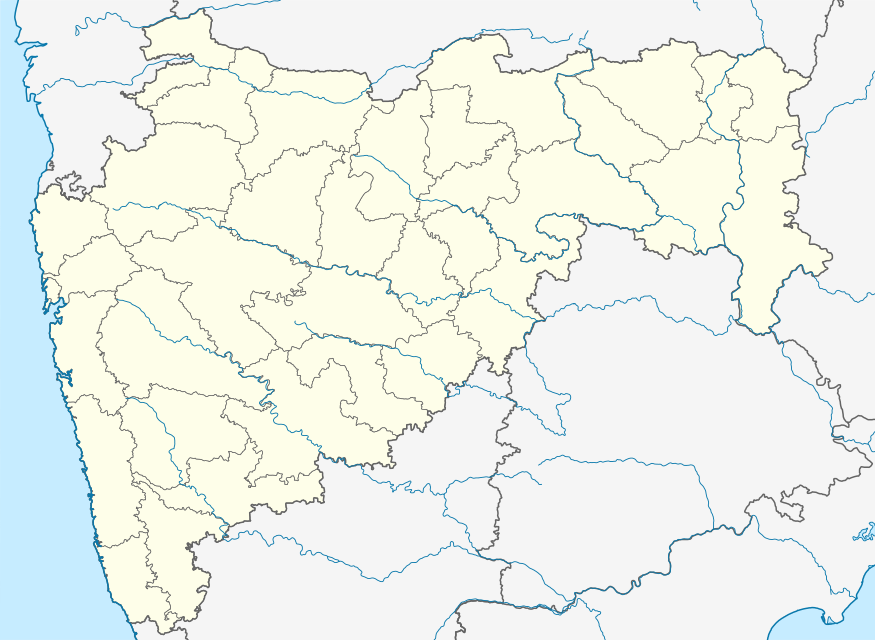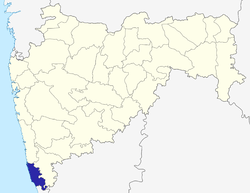Sawantwadi taluka
Sawantwadi (मराठी: सावंतवाडी) is a taluka (a unit of administration) in the Sindhudurg district in the Indian state of Maharashtra. The taluka headquarters is Sawantwadi which has a municipal council, which is a local civic body. Sawantwadi was formerly the capital of the Kingdom of Sawantwadi, ruled by the Sawant Bhonsle royal clan of the Marathas.
Sawantwadi सावंतवाडी | |
|---|---|
City | |
 Sawantwadi Location in Maharashtra, India  Sawantwadi Sawantwadi (India) | |
| Coordinates: 16°N 73.75°E | |
| Country | |
| State | Maharashtra |
| District | Sindhudurg |
| Elevation | 111.86 m (366.99 ft) |
| Population (2011) | |
| • Total | 47,921 |
| Languages | |
| • Official | Marathi |
| Time zone | UTC+5:30 (IST) |
| PIN | 416510 |
| Telephone code | 91(0)2363 |
| Vehicle registration | MH-07 |
| Website | smcsawantwadi |
Until 1850, Sawantwadi was known as Sundurwadi. The name Sawantwadi came into usage because of the surname of the state's ruling family of Khem-Sawants. The palace was earlier located on Narendra hill. Khemsawant III constructed the existing palace in late 18th century (1755–1803), and Moti-Talav (Moti Lake) was built in front in 1874.
Sawantwadi is known for its wooden toys and models thanks to an active woodcraft industry. It is also becoming a major tourist attraction.
History
Sawantwadi was the former capital of the Kingdom of Sawantwadi during the pre-independence era. In 1947, it merged into the Dominion of India. Border issues at that time with nearby areas of Belgaum and Karwar were prevalent. There were initial plans of making it a union territory as it was a Konkani speaking area, However it was merged with the old Ratnagiri district. (The district was later divided into two districts called Ratnagiri and Sindhudurg). Until the 18th century, the Kingdom of Sawantwadi included a major portion of today's North Goa district (Pedne, Bicholim, and Sattari), as well as modern Kudal and Vengurla from today's Sindhudurg district. Pedne, Bicholim, Sattari were later taken over by the Portuguese as a part of their New Conquest (between 1765 and 1788) and merged with their Old Conquest to form Goa.
Geography and climate
Sawantwadi is located at 16°N 73.75°E in the Sindhudurg district of Maharashtra.[1] It has an average elevation of 22 metres (72 ft) above mean sea level. It is the administrative headquarters of the Sindhudurg district. Sawantwadi is situated on the west coast of Maharashtra, India, and is bounded by the Arabian Sea to its west and the Western Ghats to its east. As a municipal entity, it spans an area of 132.45 km2 (51.14 sq mi), and experiences moderate to gusty winds during the day and gentle winds at night. The topography of the city ranges from plain to undulating, with several hills, valleys and flat areas within the city. The geology of the city is characterised by hard laterite in hilly tracts and sandy soil along the seashore.
The city is often used as a staging point for traffic along the Konkan Coast. Sawantwadi has a tropical climate; summer and winter months experience similar temperate conditions, with average temperatures ranging from 27 °C (81 °F) to 34 °C (93 °F). Humidity is approximately 78% on average, and peaks during May, June and July. The maximum average humidity is 93% in July and average minimum humidity is 56% in January. Under the Köppen climate classification, Sawantvadi belongs to the Tropical/megathermal zone and is under the direct influence of the Arabian Sea branch of the South-West monsoon. It receives about 90% of its total annual rainfall within a period of about six months from May to October, while remaining extremely dry from December to March. The annual precipitation in Sawantwadi is 4,242.5 millimetres (167 in).
The most pleasant months in Sawantwadi are from December to February, during which time the humidity and heat are at their lowest. During this period, temperatures during the day stay below 30 °C (86 °F) and drop to about 19 °C (66 °F) at night. This season is soon followed by a hot summer, from March to May, when temperatures rise as high as 38 °C (100 °F). The summer gives way to the monsoon season, when the city experiences more precipitation than most urban centres in India, due to the Western Ghats. Rainfall up to 4,000 millimetres (157 in) could be recorded during the period from June to September. The rains subside in September, with the occasional rainfall in October.
Demographics
As of 2011,[2] Sawantwadi had a population of 47,921, with a 50:50 ratio between males and females, based on the Indian census. Sawantwadi has an average literacy rate of 82%, higher than the national average of 59.5%: male literacy is 85%, and female literacy is 79%. In Sawantwadi, 10% of the population is under 6 years of age.
Culture
People
Most of the People of Sawantwadi, well educated & Cultured, Jatras & Dashavtari Dramas are very famous in region as well as all over Maharashtra, Due to local Language of Malvani, People of whole District are called Malvanis.
Cuisine
Typical households of Sawantwadi follow the norms of Malvani cuisine. On special occasions they eat Vade (वडे) similar to Puris and Mutton or Chicken, Fried cakes of rice and Udid flour; puran-polis, wheat cakes staffed with gram flour and sugar; and rarely, ladus, sugared and buttered wheat balls. The food of almost all household is rice, Daal, Wheat bread, Curry, vegetables as well as sea food or meat. Besides dried fish usually bought in October, Homemade Raw Mango Pickles, Salted Raw Mangoes, stores of rice, pulse, salt, and red pepper, enough to last from 6 to 12 months, are laid in during March and April.[3]
Sweet & Spicy Poha are special on Occasions of Diwali and Patolya (पातोळया) on Nag Panchami.
Attire
Attire varies from traditional Dhoti, Navwari Sarees to Kurta and Payjama, to some extent Pants & Shirt or fashion cloths on occasional basis. In addition to the traditional attire of the city, ornaments are worn by both men and women in Sawantwadi, mainly necklaces, bracelets and earrings.[3]
Arts and handicrafts
Sawantwadi is famous for its arts and culture. It is especially known for its wooden crafts, and various traditional arts still thrive in the city.
Lacquerware – Sawantwadi is well known for its lacquerware, an art form that was brought to the attention the public by Queen Satwasheela Devi. Local artisans employed in the palace have proved instrumental in the production of lacquer-ware furniture, chess sets, board games, candlesticks, fruits, vegetables, and dolls. The quality of the articles render the items extremely expensive.[4]
Village structure
According to the 1872 census, there were 221 towns and villages or about one village to every four square miles, containing an average of 840 inhabitants and about 197 houses. Of the 221 villages, 36 had less than 200 inhabitants; 57 from 200 to 500; 64 from 500 to 1,000; 41 from 1000 to 2,000; 18 from 2,000 to 3,000; four from 3,000 to 5,000; and one, Vadi, over 8,000.[5]
Language
Malvani is the predominant spoken language in Sawantwadi. Marathi is state language, spoken widely, Goan Konkani is also understood but not implemented. Hindi and English are also used in social communication.
Transport
Sawantwadi is well connected to other towns of Sindhudurg district and cities of Maharashtra state by MSRTC buses as well as Goa & Belgaum. Private buses, Sharing Rickshaws & Bikes are used to travel locally to connect the small villages to the city. Konkan Railway Corporation Limited's railway line connecting Mumbai to Mangalore, popularly known as the Konkan Railway, passes through Sawantwadi Road railway station.[6]
Near by Railways Station: Sawantwadi Road railway station
Tourist attractions
Moti Talav & Hiranyakeshi are main Attractions of Sawantwadi, Beautiful Amboli hill station is situated at distance of 29 km, Also one can Visit Mahadevgad is now known as Amboli point in deep dark forest, high hills deep valleys. Famous Math of Satam Maharaj is at Danoli Village
Hanumangad nearby trekking Point Situated in Dense forest of Village of Fukeri
Other
Raghunath Market is regarded as a major handicraft centre of India. The market is around 150 years old and is an ideal place to buy the Konkani handicraft items. These items include silver and bronze wares, jewellery and Kolhapuri Chappals.
Developing Market Town Banda is situated 12 km South of Sawantwadi.
Notable people
- V. S. Khandekar – novelist
- Mangesh Padgaonkar – poet
- Vijay Manjrekar – cricketer
- Sanjay Manjrekar – cricketer
- Vasant Desai – composer
- Bhalchandra Kadam - actor, comedian
Photo gallery
 Sawantwadi
Sawantwadi Garden
Garden Garden
Garden Playground.
Playground. Rocks on Narendra Hill
Rocks on Narendra Hill Inside the Shilpgram
Inside the Shilpgram Main Entrance of Shilpgram
Main Entrance of Shilpgram Shilpagram
Shilpagram Entrance
Entrance Tourist Residential Quarters in Sawantwadi
Tourist Residential Quarters in Sawantwadi
See also
| Sawantwadi Road (SWV) | |||
| Next 'Small' station towards Mumbai : Zarap |
Konkan Railway : Railway (India) | Next 'Small' station from Mumbai: Madure | |
| Distance from Mumbai (CST) = 0655 km | |||
| Next 'Main' station towards Mumbai: Kudal |
Konkan Railway : Railway (India) | Next 'Main' station from Mumbai: Madgaon | |
References
- "Sawantwadi, India Page". Falling Rain Genomics, Inc. Retrieved 19 March 2008.
- "Census of India 2001: Data from the 2001 Census, including cities, villages and towns (Provisional)". Census Commission of India. Archived from the original on 16 June 2004. Retrieved 1 November 2008.
- Ratnagiri and Savantvadi District Gazetteer 1996, Introductory Details
- Devarajan, P. (5 October 2002). "A craft struggles to survive – Amid the sights and sounds of Sawantwadi". The Hindu Business line. Retrieved 5 June 2009.
- Ratnagiri and Savantvadi District Gazetteer 1996, Villages
- "KR station with phone and amenities". www.konkanrailway.com. Retrieved 9 October 2012.
External links
- Sawantwadi Municipal Corporation
- Ratnagiri and Sawantwadi District Gazetteer. X. The Gazetteers Department (Government of Maharashtra). 1996 [1880]. Retrieved 15 January 2009.
- Sawantwadi in Google Maps
- Sawantwadi on Outlook Traveller
